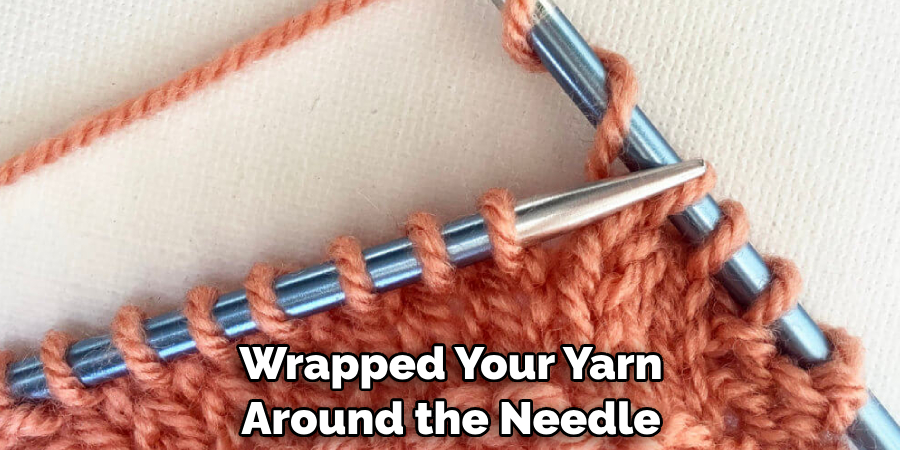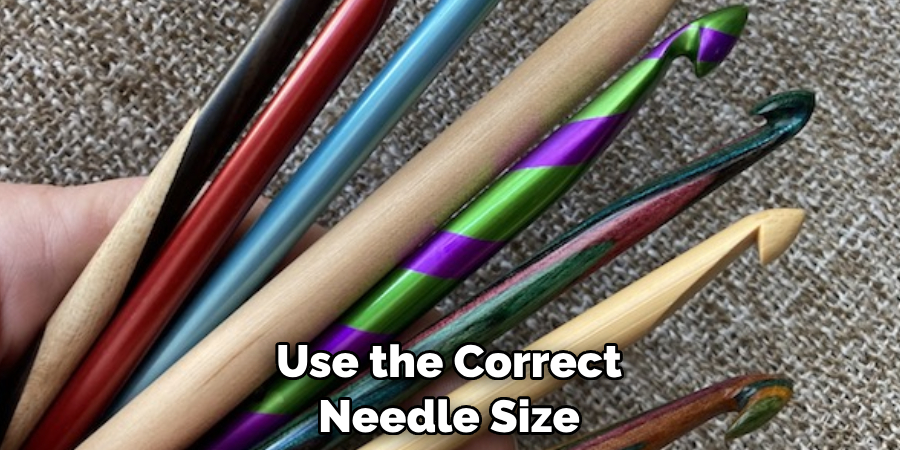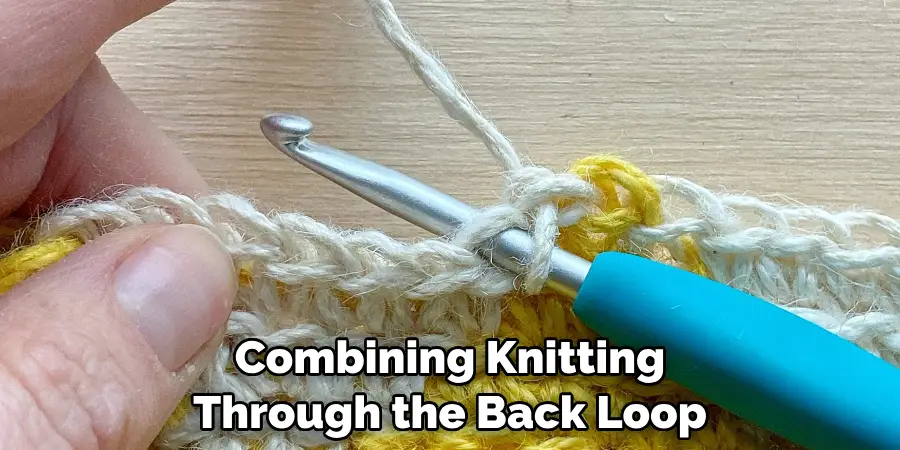Knitting through the back loop will help you create a beautiful and unique look for your projects. It is an easy technique that can be used to create ribbing and more complex patterns. The back loop will add texture and depth to any project, making it visually interesting.
Knitting through the back loop can create various textures in your work. It adds depth and interest to any project, making it stand out from other projects. Additionally, it can be used to create ribbing or more complicated patterns for an even more eye-catching effect. In this blog post, You will learn how to knit through back loop.

Step-by-step Instructions for How to Knit Through Back Loop
Step 1: Inspect Your Knitting Piece
Before you start knitting, take a minute to inspect your piece. Look for areas where the back loop stands out, such as around the edges of cables and ribs.
Step 2: Insert Your Needle Into the Back Loop
Once you’ve identified a back loop, insert your needle into it from the front side of your knitting piece. Make sure to insert the needle into the same side of the loop as you normally would when knitting. Then, wrap your yarn around your needle in a clockwise direction. Ensure that the yarn is wrapped tightly around your needle and that there are no loose ends or gaps.
Step 3: Slip Your Stitch off of the Needle
Once you’ve wrapped your yarn around the needle, slip your stitch off of the needle. Be careful not to pull too tightly, or it may cause the stitch to unravel. Now that your stitch is off the needle, pull your yarn through the back loop. This will create a new stitch and help to secure the existing stitches.
Step 4: Insert Your Needle Into The Stitch From Back To Front
After you’ve pulled your yarn through the back loop, insert your needle from back to front into the same stitch again. Make sure you insert the needle into the same side of the loop as you normally would when knitting. Once again, wrap your yarn around your needle in a clockwise direction. Ensure no loose ends or gaps and that the yarn is wrapped tightly around the needle.
Step 5: Slip Your Stitch off of the Needle
Once you’ve wrapped your yarn around the needle, slip your stitch off of the needle. Be careful not to pull too tightly, or it may cause the stitch to unravel. Now that your stitch is off the needle, pull your yarn through the back loop again. This will create an additional stitch and help to secure the existing stitches.

Step 6: Pull The Yarn Tight
After you’ve pulled your yarn through the back loop, pull it tight. This will ensure that all of your stitches are held securely. Knitting through the back loop is a simple technique that can be used to create interesting textures and patterns in your knitting.
Tips for How to Knit Through Back Loop
- Use the correct type of knitting needles for your project – different materials are suited to various needle sizes and types.
- Always keep your working yarn tight by adjusting the tension when necessary.
- Keep count of how many stitches you have knit – this will help you avoid dropping or adding stitches while working with back loop knitting.
- Be careful when changing yarn colors – always tie off one strand before beginning the next color, and keep your working yarn tension tight and consistent throughout.
- Take frequent breaks from knitting to prevent hand fatigue or injury, especially if using a full-size set of needles.
- Keep your knitting tools clean and free from debris.
- If you ever have any doubts about what type of stitches you have completed or if your project looks uneven, it is always better to take a few extra minutes and double-check your knitting work rather than continuing with the wrong technique.

With careful practice of knitting through a back loop, you will be a knitting pro in no time.
What is the Best Way to Hold Your Yarn When Knitting Through the Back Loop?
When knitting through the back loop, it is important to keep your yarn in an even tension to ensure that all of your stitches look uniform and secure. There are two main methods for holding your yarn while working with a back loop stitch: English or Continental. English-style knitting requires you to hold your yarn in one hand (usually the right) and use the other hand (usually the left) to control the knitting needles.
This method is often favored by knitters new to knitting, as it allows for greater control over tension and stitch size. Meanwhile, Continental style knitting requires you to hold your yarn in one hand (usually the left) while using both hands on the needles. This style may take a bit of practice to get used to, but it can be constructive for knitting patterns that involve multiple colors or complicated design elements.
What Are Some Tips for Maintaining an Even Tension When Knitting Through the Back Loop?
Maintaining an even tension is key to achieving a beautiful finished project when knitting through the back loop. Here are some tips for getting it right:
- Start by practicing on a few swatches of knit fabric. This will help you understand how much pressure to apply while stitching and allow you to adjust your tension if needed.
- Check the yarn tail every few rows to ensure it is not pulling too tightly, causing your stitches to become uneven.
- Keep count of how many rows you have knitted – this will help you keep track of any changes in stitch size or tension.
- If the fabric starts to pucker, try loosening the tension by millimeters.
- Ensure you use the correct needle size for the yarn; different materials require different-sized needles.
- Take frequent breaks from knitting to prevent hand fatigue or injury, especially if you are using a full-size set of knitting needles.

Following these tips and practicing your knitting skills, you can create beautiful, even stitches when working with back-loop knitting.
What Are Some Common Mistakes to Avoid When Knitting Through the Back Loop?
When knitting through your stitch’s back loop (TLB), it is important to avoid making a few common mistakes. The most common mistake when TLB is to work into the front or wrong loop instead mistakenly. This will cause an irregular edge in your work. To avoid this mistake, ensure you are working into the back loop of each stitch.
Additionally, it is important to keep your tension even when knitting through the back loop, as this will ensure an even and consistent edge. Another common mistake is when TLB works too tightly or loosely on the edge stitch. When this happens, your edges won’t look neat and tidy, so practicing keeping your tension even is important.
Are There Any Additional Resources You Should Check Out for More Information on This Particular Technique?
Yes! If you’re looking for more information on knitting through the back loop, you can check out some available resources. YouTube is a great source for videos on how to do this technique in detail, and there are many websites with helpful tutorials.
Additionally, many knitting stores offer classes or workshops that focus specifically on this technique so they can provide more personalized instruction. Finally, you can always join a knitting group or forum to share advice and ask questions with other knitters who have experience with this technique.
What Are Some of the Benefits of Knitting Through the Back Loop?
Knitting through the back loop (abbreviated as “tbl” in knitting patterns) is an easy technique that can be used to create a variety of interesting and unique textures. This technique can add visual interest to your projects and provide added strength and stability.

It also helps prevent gapping between knit stitches, which can result in decreased stitch definition. Combining knitting through the back loop with other techniques, such as ribbing and cables, can create stunning pieces that will make your work stand out from the crowd.
Knitting through the back loop also allows versatility when creating different patterns. For example, knitting through the back loop can help create a more defined texture if you are making a ribbed pattern. If you are knitting cables, using the tbl technique will create an even twist in the cable pattern.
Conclusion
In conclusion, knitting through the back loop is a great technique for completing various projects. It can be used to create more intricate details in your knitted pieces and provide added detail and texture to your knitting. Knitting through the back loop can also help you make sturdy and neat edges. With practice, you’ll soon be able to knit any pattern easily.
Finally, always take your time when learning any new knitting technique. It might feel awkward initially, but with practice, you’ll soon be able to knit through the back loop effortlessly. Reading this post has helped you learn how to knit through back loop. Make sure the safety precautions are carried out in the order listed.

